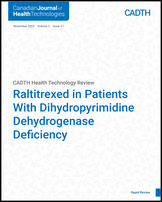| Gallois et al. (2022)13 France Funding source: No specific funding received for this report | Retrospective multicentre study with data since 2006 | Patients with metastatic colorectal cancer (N = 75)Characteristics of relevant subgroup (N = 36):Mean age, years: 65.4 WHO-PS 0 to 1 rate: 94%
Characteristics of full sample (N = 75):Male, n (%): 51 (68) Location of primary tumour, n (%): Median serum CEA, ng/mL (range): 15 (0 to 2,169)
| Intervention: Raltitrexed, single-agent or combination chemotherapy; combinations were raltitrexed with:From entire sample:Comparators: | Outcomes:Median follow-up from full sample, months (95% CI): 51.3 months (41.9 to not reached); until death or last follow-up |
| Batra et al. (2021)14 Canada Funding source: NR | Retrospective, population-based review of provincial administrative data from 2004 to 2018 | Patients with metastatic colorectal cancer, initially treated with fluoropyrimidine-based systemic therapy and developed serious cardiac and/or non-cardiac adverse events (N = 86)Cardiac events (n = 32, 37.6%) Non-cardiac events (n = 64, 63.4%)
Median age, years (IQR): 66.5 (42 to 86)Male patients, n (%): 50 (58.1%) Primary cancer site, n (%): Previous lines of systemic therapy, n (%):1 or 2: 49 (57.0) > 2: 37 (43.0)
ECOG performance status (N = 84), n (%):0 or 1: 68 (81.0) 2 or 3: 16 (19.0)
Median serum CEA (N = 26), ug/L (IQR): 35.5 (5.4 to 470) | Intervention: Raltitrexed (single-agent or combination with irinotecan)1 patient received combination; all other patients received raltitrexed alone Median number of cycles (range): 3 (1 to 23) Dose: 3 mg/m2 every 3 weeks (except 1 patient who received raltitrexed and irinotecan)
Comparators: | Outcomes:Median follow-up, months: 46.7 |
| Khan et al. (2018)15 UK Funding source: Unclear; reported support and research funding received by authors, but unclear which funding sources supported this study. | Retrospective single-centre cohort study with data from 1998 to 2011 | Patients with gastrointestinal cancer (N = 247)Characteristics of full sample (N = 247):Female, n (%): 179 (72.5) Mean age (range), years: 65.5 (31 to 88) Type of cancer, n (%):
| Intervention: Raltitrexed (single-agent or combination chemotherapy; combinations not reported)From entire sample:Approximately 31% and 68% received single-agent and combination respectively Standard dose: 3 mg/m2 as a 15-minute infusion; 22% received reduced doses (1.3 to 2.8 mg/m2); 44% received higher doses (3.10 to 6.60 mg/m2)
Comparator: Fluoropyrimidines (5-FU- or capecitabine-containing chemotherapy; before-after) | Outcome: Cardiac adverse events Median follow-up (IQR), months from full sample: 47.1 (32.4 to 65.7) |
| Ransom et al. (2014)16 Australia Funding source: Astra Zeneca | Retrospective multicentre review of pharmacy and medical records from 2004 to 2012 | Patients with cancer who had cardiac toxicity with 5-FU or capecitabine (N = 42) Median age (range), years: 62 (36 to 81) Patients by type and stage of cancer at time of initiating raltitrexed, n: Colorectal (stage II or III): 14 Colorectal (stage IV): 25 Esophageal (stage II or IV): 2 Ampullary (stage IV): 1
| Intervention: Raltitrexed (single agent [N = 11] or combination [N = 31])Comparator: Fluoropyrimidines (5-FU or capecitabine, alone or combination; historical control) | Outcome: Rate of further cardiac events attributed to chemotherapy Follow-up: up to 30 days after last dose of raltitrexed |
| Kelly et al. (2013)12 UK Funding source: Unclear; mentions financial support from Hospira UK Ltd., but unclear if this was for conducting the study or for editorial assistance | Retrospective review of medical records at 2 treatment centres from 2008 to 2011 | Patients with gastrointestinal tumours (N = 111):Characteristics from full sample (N = 111): | Intervention: Raltitrexed (unclear if single-agent and/or combination) Comparator: Fluoropyrimidines (5-FU or capecitabine; before-after) | Reported outcomes: Cardiovascular or cerebrovascular complications Follow-up: NR |
